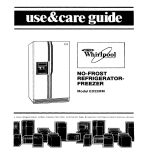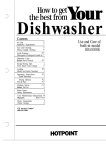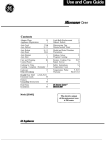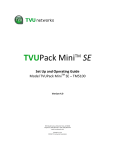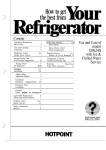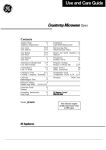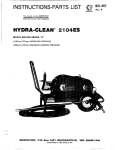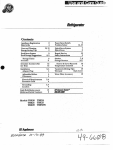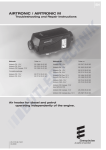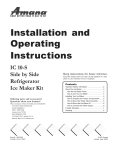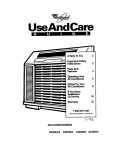Download Monogram. Use and Care Guide for 48” Built
Transcript
Monogram. Use and Care Guide for 48” Built-In Refrigerator 1993 Mompam.TM ZS48N ZSB48D ZSW48D Introduction Your new Monogram refrigerator makes an eloquent statement of style, convenience and kitchen planning flexibility. Whether you chose it for its purity of design, practical storage arrangements or assiduous attention to detail—or for all of these reasons—you’ll find that your Monogram refrigerator’s superior blend of form and function will delight you for years to come. The Monogram refrigerator was designed to provide the flexibility to blend in with your kitchen cabinetry. Decorative door insert panels allow it to match your kitchen cabinets or blend with your kitchen decor. Custom handles are also available to further personalize your refrigerator. Through a series of product and trim kit choices, the Monogram refrigerator can be beautifully integrated into the kitchen. Since this is designed to be a built-in product, custom panels are required on the front of the Monogram refrigerator. Consult your kitchen designer or cabinetmaker for your customized look. The information on the following pages will help you operate and maintain your refrigerator properly. For more information, please refer to the following publications: 24-MO02 Product Planning and Installation Information 49-6457 Installation Instructions 49-6458 Trim Options and Instructions These can be obtained from a GE Monogram dealer. For a listing of dealers—or if you have other questions—please call the GE Answer Center” (800.626.2000). Contenk Appliance Registration .................3 Care and Cleaning . . . . . . . . . . . . . . . . 13–16 Condenser ............................14 Drawer/Cover Removal .......16 Light Bulb Replacement ......15 Vacation Tips .......................16 Consumer Services .....................22 Food Storage Suggestions ..........10 Storage Times ......................10 Ice and Water Dispenser ...........6–9 Installation .................................17 Adapter Plug . . . . . . . . . . . . . . . . . . . . . . . . 17 Clearances ............................17 Electrical Requirements .......17 Grounding ............................17 Leveling . . . . . . . . . . . . . . . . . . . . . . . . . . . . . . . 17 Model and Serial Numbers ...........3 Power Saver Switch ......................5 Problem Solver .....................18–20 Safety Instructions ........................4 Shelves . . . . . . . . . . . . . . . . . . . . . . . . . . . . . . . . . . . . . ...12 Storage Drawers . . . . . . . . . . . . . . . . . . . . . . . . . .11 Temperature Controls ...................5 Water Filter Accessory .................9 Warranty .....................................23 Read this book carefully. It is intended to help you operate and maintain your new refrigerator properly. Keep it handy for answers to your questions. If you don’t understand something or need more help, write (include your phone number): Consumer Affairs GE Appliances Appliance Park Louisville, KY 40225 Write down the model and serial number. You’ll see them on a label on the right side, near the bottom of the fresh food compartment. These numbers are also on the Consumer Product Ownership Registration Card that came with your refrigerator. Before sending in this card, please write these numbers here: Model Number Serial Number Use these numbers in any correspondence or service calls concerning your refrigerator. If you received a damaged refrigerator... Immediately contact the dealer (or builder) that sold you the refrigerator. Save time and money. Before you request service... Check the Problem Solver in the back of this book. It lists causes of minor operating problems that you can correct yourself. If you need service... To obtain service, see the Consumer Services page in the back of this book. We’re proud of our service and want you to be pleased. If for some reason you are not happy with the service you receive, here are three steps to follow for further help. FIRST, contact the people who serviced your appliance. Explain why you are not pleased. In most cases, this will solve the problem. NEXT, if you are still not pleased, write all the details—including your phone number—to: Manager, Consumer Relations GE Appliances Appliance Park Louisville, KY 40225 FINALLY, if your problem is still not resolved, write: Major Appliance Consumer Action Panel 20 North Wacker Drive Chicago, IL 60606 3 OPEMT~G YOUR REFWGEMTOR Set Temperature Controls Your refrigerator has two controls that let you regulate the temperature in the fresh food and freezer compartments. ::;::ffl:!~ FRESH FOOO — They have settings from 1 through 9, and are located at the top of the fresh food compartment. The freezer control also has an OFF setting. 9 is the coldest setting, 1 is the warmest. 5 IS NORMAL E 91 SCOLDEST FREEZER WHEN YOU FIRST TURN THE REFMGERATOR ON, SET BOTH CONTROLS AT 5. For colder or warmer temperatures, adjust the desired compartment control one number at a time. IMPORTANT: When first settin~ controls. or adjusting them, allow 24 hours for the refrigerator to get cold. NOTE: Turning the freezer control to the OFF position stops cooling in BOTH compartments— fresh food AND freezer—but does not shut off power to the refrigerator. How to Test Temperatures Use the milk test for the fresh food compartment. Place a container of milk on the top shelf in the fresh food compartment. Check it a day later. If the milk is too warm or too cold, adjust the temperature controls. freezer compartment. Place a center of the freezer compartment. ‘::::::::::::he Check it after a day. If it’s too hard or too soft, adjust the temperature controls. E Power Saver Switch The power saver switch is located on the temperature control panel. To reduce the amount of electricity required to operate your refrigerator, push switch to POWER SAVER setting. This turns off the heater in your refrigerator that prevents moisture from forming on the outside of the refrigerator. With the heater turned off, there is a chance that moisture may form on the outside of your refrigerator, especially when the weather is humid. The humidity is most likely to be high in the summer, in the early morning hours, and in homes which are not air conditioned. Over an extended period of time, moisture that forms on the refrigerator surface may cause deterioration of the paint finish. It will be important to protect the finish by using appliance polish wax as described in the Care and Cleaning section. Move the power saver switch from the POWER SAVER setting and electricity flows through the low wattage heater which warms the outside of the refrigerator. Under most conditions, this prevents the forming of moisture or water droplets. No Defrosting It is not necessary to defrost the freezer or fresh food compartments. Although your refrigerator is designed and equipped to defrost itself automatically, some frost on packages is normal. 5 ICE & CH~LED WATER DISPENSER (on some models) Automatic Icemaker and Ice & Chilled Water Dispenser Some models have an automatic icemaker and a dispenser that dispenses chilled water, ice cubes and crashed ice through the freezer compartment door. Here’s how they work. Water flows from the household supply through a (1) dual solenoid valve to the (2) water reservoir and to the (3) automatic icemaker as needed. 6 Water is frozen in the (4) cube mold and ejected into the (5) storage bin where a motor-powered auger moves cubes forward into the dispensing unit. Cubes or crushed ice, as selected, dispense through chute in door when cradle is pressed. When the switch is moved to CRUSHED, the baffle in housing channels cubes through the crusher and crushed ice falls through chute into glass. Chilled water from reservoir flows through the (6) tubing in the door and is dispensed when the cradle is pressed. (7) A light switch turns the night light in the dispenser on and off. Before Using Your Icemaker and Dispenser If you use your refrigerator Ice access before the water connection is door made, raise the ice access door w I and make sure the icemaker Icemaker feeler arm is in the STOP (up) position as shown below. 9 Ice cube mold automatic fills with water after cooling to freezing temperatures. First cubes normally freeze after several hours. m in NOTE: With a newlyn) installed refrigerator, allow about 24 hours for the freezer compartment to cool down to the proper ice-making temperature. arm in (up) n water line and to fill water reservoir automatically. Once Your Icemaker and Dispenser are in Operation Throw away the first few batches of ice cubes (16 or 24 cubes). This will flush away any impurities in the water line. Do the same thing after vacations or extended periods when ice isn’t used. Discard the first six glassfuls of water in the kitchen sink. This will eliminate the slight “plastic” taste temporarily imparted to the water by the water reservoir. Keep ice level to keep icemaker productive. Cubes ejected into an empty storage bin will pile up close to the icemaker and push the feeler arm up to the STOP position prematurely when the bin is only partially full. Open the ice access door, reach in, level the cubes by hand and icemaking will resume. Keeping cubes distributed evenly will allow the icemaker to produce enough ice to fill the bin to its maximum capacity. Caution: Under cefiin rare circumstances, ice cubes may be discolored, usually appearing with a greenbluish color. The cause of this unusual discoloration is apparently du~ to a combination of factors such as cefin characteristics of local waters, household plumbing and the accumulation of copper salts in an inactive water supply line which feeds tie icernaker. Continued consumption of such discolored ice cubes maybe injurious to health. If such discoloration is observed, discard the ice cubes and contact your GE Factory Service Center or an authorized Customer Care” Servicer. To Dispense Ice and Water For ice, set selector switch to CUBED, CRUSHED or CHILLED WATER. Grip glass or other container gently near the rim and press rim firmly against dispenser cradle. I CAUTION: Never put fingers orother objects into theicecrusher discharge opening. I I I (continued next page) 7 ICE & CH~LED WATER DISPENSER (continued) When Dispensing Ice... When Dispensing Water... Some crushed ice may be dispensed even though you selected CUBED. This happens occasionally when a few cubes accidentally get channeled to the crusher. Sometimes a mound of snow will form on the door in the ice chute. This condition is normal, and usually occurs when you have dispensed crushed ice repeatedly. The snow will eventually evaporate. The water system provides approximately six successive 6-ounce glassfuls—after which several hours must be allowed for replenished water reservoir supply to cool. You probably will not drain all the chilled water from the reservoir on a single occasion. The first glass of water dispensed maybe warmer than the following ones. This is normal. Dispensed water is chilled, not iced. For colder water, simply add crushed ice or cubes before dispensing water. To Stop Dispensing Release uressure from cradle and withdraw slowly to catch ~ast bits of ice or drops of water. Some slight dripping may occur following dispensing of crushed ice or chilled water. If excessive, the spill should be wiped dry immediately. Do not pour water in spill shelf because it is not self-draining—pour it in the kitchen sink. The shelf and its grille should be cleaned regularly according to the Care and Cleaning section. ~ ,! If Ice Clumps Form in Storage Bin... The icemaker ejects cubes in groups of eight, and it is normal for several cubes to be joined together. However, infrequent usage of ice can cause ice clumps to form in the storage bin, resulting in temporary malfunction of the dispenser mechanism. If this happens: ● Remove storage bin from freezer compartment. ● Break up ice clumps with fingertip pressure and discard remaining clumps. ● Replace bin before remaining cubes melt and fuse together. To Remove Ice Cube Storage Bin Lift the left corner to free the bin from the shelf, and pull the bin straight out while supporting it at front and back. \ $ To Replace Ice Cube Storage Bin If Ice Is Not Used Frequently . . . Slide the bin back until the tab on the bin locks into the slot in the shelf. If the bin does not go all the way back, remove it and rotate the drive mechanism 1/4 turn. Then push bin back again until the tab on the bin locks into the slot in the shelf. “Old” ice cubes will become cloudy and taste stale. Empty ice storage bin periodically and wash it in lukewarm water. Be sure to allow storage bin to cool before replacing it—otherwise ice cubes will stick to the metal auger. Move Icemaker Feeler Arm to STOP (up) Position When... Home water supply is to be turned off for several hours. ● Ice storage bin is to be removed for a period of time. ● Going away on vacation, at which time you should also turn off the valve in the water supply line to your refrigerator. ● If This Is Your First Icemaker... You’ll hear occasional sounds that may be unfamiliar. These are normal icemaking sounds and are not cause for concern. Water Filter Accessory The pefiect companion to your automatic icemaker—a water filter. Your ice cubes can only be as fresh-tasting as the water that produces them. That’s why it’s a good fi 9 FOOD STOMGE SUGGESTIONS Suggested storage times for meat and poultry* Eating quality drops after time shown DAYS IN MONTHS IN REFRIGERATOR FREEZER AT 35° to 40”F. AT OOF. Fresh Meats DAYS IN MONTHS IN REFRIGERATOR FREEZER AT 35o to 40°F. AT O°F. Cooked Meats Roasts (Beef & Lamb) ,........3 to 5 Roasts (Pork & Veal) ...........3 to 5 Steaks (Beef) .......................3 to 5 Chops (Lamb) ......................3 to 5 Chops (Pork) .......................3 to 5 Ground & Stew Meats ,,,,,,,,,1 to 2 Variety Meats .......................l to 2 Sausage (Pork) ....................l to 2 6 to 12 4 to 8 6 to 12 6 to 9 3 to 4 3 to 4 3 to 4 1 to 2 Processed Meats Bacon ......................................7 Frankfurters.............................7 Ham (Whole) ...........................7 Ham (Half) ...........................3 to 5 Ham (Slices) ...........................3 Luncheon Meats ..................3 to 5 Sausage (Smoked) ..................7 Sausage (Dry & Semi-Dry) .14 to 21 Eating qualih drops after time shown 1 % 1 to 2 1 to 2 1 to 2 Freezing not recommended. Cooked Meats and Meat Dishes.....................3 to 4 GraW & Meat Broth .............1 to 2 2 to 3 2 to 3 Fresh Poultry Chicken & Turkey (Whole)...l to 2 Chicken (Pieces) ..................l to 2 Turkey (Pieces) ....................1 to 2 Duck & Goose (Whole) ........l to 2 Giblets. ....,,,,,.......................1 to 2 12 9 6 6 3 Cooked Poultry Pieces (Covered with Broth)l to 2 Pieces (Not Covered) ...........3 to 4 Cooked Poultry Dishes ........3 to 4 Fried Chicken .......................3 to 4 6 1 4 to 6 4 (Otherthanfor meats&poultry) FREEZER Most fruits and vegetables..................8-l2 months months Lean fish ..............................................6-8 Fatty fish, rolls and breads, soups, stew, casseroles ...................2-3 months Cakes, pies, sandwiches, leftovers (cooked), ice cream (original carton) .............l month max. *U.S. Depaflmerrt of Agriculture Meats, fish and poultry purchased from the store vary in quality and age; consequently, safe storage time in your refrigerator will vary. Fresh Food Storage Tips To store unfrozen meats, fish and poultry: ● Always remove store wrappings. ● Rewrap in foil, plastic wrap or wax paper and refrigerate immediately. To store vegetables, use the vegetable drawers— they’ve been designed to preserve the natural moisture and freshness of produce. “ Covering vegetables with a moist towel helps maintain crispness. As a further aid to freshness, prepackaged vegetables can be stored in their original wrapping. To store cheese, wrap well with wax paper or aluminum foil, or put in a plastic bag. ● Carefully wrap to expel air and help prevent mold. ● Store prepackaged cheese in its own wrapping if you wish. ● New techniques are constantly being developed. Consult the Coun@ Extension Service or your local Utility Company for the latest information on freezing and storing foods. Tips on Freezing Food There are three essential requirements for efficient home freezing. 1. Initial quality. Freeze only topquality foods. Freezing retains quality and flavor; it cannot improve quality. 2. Speed. The quicker fruits and vegetables are frozen after picking, the better the frozen product will be. You’ll save time, too, with less culling and sorting to do. 10 3. Proper packaging. Use food wraps designed especially for freezing. To freeze meat, fish and poultry, wrap well in freezer-weight foil (or other heavy-duty wrapping material), forming it carefully to the shape of the contents. This expels air. Fold and crimp ends of the package to provide a good, lasting seal. Don’t refreeze meat that has been completely thawed; meat, whether raw or cooked, can be frozen successfully only once. Fine-quality ice cream, with high cream content, will norrndly require slightly lower temperatures than more “airy” already-packaged brands with low cream content. ● It will be necessary to experiment to determine the freezer compartment location and temperature control setting to keep your ice cream at the right serving temperature. ● The rear of the freezer compartment is slightly colder than the front. Effervescent drinks should not be stored in freezer compartment. STOMGE DMWERS Fruit and Vegetable Drawers The storage drawers at the bottom of the fresh food compartment are designed to provide high humidity levels required by most vegetables and lower humidity levels required for most fruits. When replacing the drawers, always push them all the way in. Storage time will depend upon the type of food and its condition when placed in the drawers. Excess water that you may find in the bottom of the drawers should be emptied and the drawers wiped dry. ~~ Sealed Drawers Unsealed Drawers This refrigerated drawer is designed to keep unwrapped foods fresh by retaining the natural moisture content of foods such as: This refrigerated drawer is designed to provide lower humidity storage for items such as: Atiichokes ● Asparagus ● Beets, topped ● Blueberries ● Carrots ● Rhubarb ● Spinach ● Tomatoes, ripe . Lettuce Celery ● Parsley ● Cherries ● Peas, green ● Corn ● Plums ● Currants ● Greens, leafy ● Radishes ● ● Apples Apricots ● Grapes ● Mushrooms Nectarines Oranges ● Peaches ● Pears ● ● ● ● Raspberries Squash, summer ● Strawberries ● Tangerines ● ● As in any refrigerated storage area, it is recommended that foods with strong odors be stored wrapped—foods such as: ● ● Broccoli Brussels sprouts Cabbage Cauliflower ● Green onions ● ● ● ● Parsnips Turnips Sealed Snack Pan The Sealed Snack Pan retains high humidity for the convenient storage of meats and cheese, bacon, hors d’oeuvres, spreads and snacks. )Uw flli: 11 SHELVES How to Rearrange Your Shelves Adjustable Shelves in Both Compartments Tempered glass shelves in the fresh food compartment and steel wire shelves in the freezer compartment are adjustable, enabling you to make efficient shelf arrangements to fit your family’s food storage needs. o 0 o 1 n 0 0 I Inl To remove shelves: Tilt shelf up at front, then lift it up and out of tracks on rear wall of refrigerator. To replace shelves: Select desired shelf height. With shelf front raised slightly, engage top lugs in tracks at rear of cabinet. Then lower front of shelf until it locks into position. Removable Wine Rack (on some models) b n n 1181 ! n o n n no The wine rack is designed to hold a bottle on its side and will fit on any shelf. Adjustable Shelves on Both Doors Door shelves can be moved up and down to meet your storage requirements. To remove: Lift the shelf up and slide it towards you. 12 To relocate the wine rack: Pull the wine rack straight out, position its lip over the right edge of the shelf you want to suspend it from and push it all the way in. CAm Am CLEAN~G Cleaning—Oubide The water and ice dispenser spill shelf should be wiped dry immediately to prevent spotting. Water left on the shelf may leave deposits that you can remove by soaking in undiluted vinegar. You can also use a paste of non-precipitating water softener (such as Calgon brand) and water, or one teaspoon of citric acid powder per pint of hot tap water. Soak until the deposit disappears or becomes loose enough to rinse away. Usually 30 minutes soaking time is adequate. Avoid using wax on the spill shelf and trim. The door handles and trim can be cleaned with a cloth dampened with a solution of mild liquid dishwashing detergent and water. Dry with a soft cloth. Don’t use wax on the door handles or trim. Cleaning—Inside Inside the fresh food and freezer compartments should be cleaned at least once a year. Unplug the refrigerator before cleaning. If this is not practical, wring excess moisture out of sponge or cloth when cleaning around switches, lights or controls. Use warm water and baking soda solution—about a tablespoon of baking soda to a quart of water. This both cleans and neutralizes odors. Rinse thoroughly with water and wipe dry. Other parts of the refrigerator—including door gaskets, meat and vegetable drawers, ice storage bin and all plastic parts-can be cleaned the same way. After cleaning door gaskets, apply a thin layer of petroleum jelly to the door gaskets at the hinge side. This helps keep the gaskets from sticking and bending out of shape. Do not use cleansing powders or other abrasive cleaners. To help prevent odors, leave an open box of baking soda in the rear of the refrigerator, on the top shelf. Change the box every three months. An open box of baking soda in the freezer will absorb stale freezer odors. 13 CA~ Am CLEANING (continued) Condenser To clean the condenser fins: First turn off the power at the circuit breaker or fuse box. Wait about 30 minutes for the condenser area to cool. Then remove the decorative panel by lifting up and toward you. Condenser fins Grille 14 _ Condenser fins rille Use a soft bristle brush to loosen dust and lint on the condenser fins. Use a vacuum hose to remove soil. After cleaning: Reconnect power at the fuse box or circuit breaker. Replace the decorative panel. CAUTION: The grille below the decorative panel provides necessary air circulation. Do not cover or alter the grille or damage to the cooling unit may occur. Light bulb replacement in the fresh food compartment There are upper and lower light bulbs in the fresh food compartments. To replace a bulb: 1. Turn off power at the circuit breaker or fuse box. 2. Remove the light shield from the top fresh food light by pushing the front end up and pulling it toward you to release it from the rear retaining lip. (It may bend slightly.) To change the bottom refrigerator light, pull out the top drawer, look to the rear of the fresh food compartment and replace bulb as needed. 3. Replace with the same size bulb, reinstall the shield for the upper fresh food light, and turn the power on. To reinstall the upper fresh food shield, hook the front edge first, then push it up and back until the shield rests in place. / / ~ : D a * ~ n D o Light bulb replacement in the freezer compartment To replace a bulb: 1. Turn off power at the circuit breaker or fuse box. 2. Remove the freezer light shield by pulling the front edge down and free and then pull it toward you. 3. Replace with the same size bulb, reinstall the shield, and turn the power on. To replace the freezer shield, set the back edge on the rear tabs and then push up in the front until it rests in place. You may bend the shield slightly to help in removal and replacement. (continued next page) 15 CAm Am CLEAN~G (continued) Drawer and Cover Removal Drawers at the bottom of the fresh food compartment will stop before coming all the way out of the refrigerator, to help prevent contents from spilling onto floor. These drawers can be removed easily by grasping the sides and lifting up slightly while pulling drawer past “stop” location. 1. Remove food from the shelf above the upper drawer and take out the shelf. 2. Pull the upper drawer forward and lift the front to clear the stops. To remove drawers and their covers when the refrigerator door cannot be opened fully: 1. Pull the upper drawer partway out. Reach in, push the cover up; tilt it and take it out. 2. Roll the drawer forward and up, tilt the drawer and take it out. Remove the lower drawer the same way. When you goon vacation For extended vacations or absences, remove food and shut off power to the refrigerator at the fuse box or circuit breaker. Clean the interior with a baking soda solution of one tablespoon of soda to one quart of water. Wipe dry. To prevent odors, leave an open box of soda in the refrigerator. Leave doors open. 16 =m.+—,0 .— .,...,.., 0 ObK/mG .2 $7? Dh .,.-., .-. ....... For shorter vacations, remove perishable foods and leave controls at regular settings. However, if the room temperature is expected to drop below 60°F., follow the same instructions as for extended vacations. Move the icemaker feeler arm to the STOP (up) position and be sure to shut off the water supply to the refrigerator. ~STALLATION ~QUI~MENTS WORTANT...Pleme Read Careftiy. How to connect electricity For personal safety, this appliance must be properly grounded. The power cord of this appliance is equipped with a three-prong (grounding) plug which mates with a standard three-prong (grounding) wall outlet (Fig. 1) to minimize the possibility of electric shock hazard from this appliance. I Fig. 1 INSURE PROPER GROUND ‘ EXISTS BEFORE USE Have wall outlet and circuit checked by a qualified electrician to make sure outlet is properly grounded. Where a standard two-prong wall outlet is encountered, it is your personal responsibility and obligation to have it replaced with a properly grounded three-prong wall outlet. DO NOT USE AN ADAPTER PLUG TO CONNECT THE REFRIGERATOR TO A TWO-PRONG OUTLET. DO NOT USE AN EXTENSION CORD WITH THIS APPLMNCE. The refrigerator should always be plugged into its own individual electrical outlet—(1 15 volt, 60 Hertz, single phase AC—protected by a 20-amp time delay fuse or circuit breaker). This is recommended for best performance and to prevent overloading house wiring circuits, which could cause a fire hazard from overheating wires. IMPORTANT: The water line and the electrical outlet must be installed in the exact location described in the Installation Instructions (Pub. No. 49-6457). Refrigerator Location Clearances Install the refrigerator on a floor strong enough to support it when it is fully loaded. Do not install refrigerator where temperature will go below 60°F. because it will not run often enough to maintain proper temperatures. If the refrigerator is to be installed in a corner, allow 2“ between the hinges of the refrigerator and the wall to assure a 90° door opening capability. No other clearances at top, sides or back are required. Leveling This model has 4-point leveling. All four corners are supported by leveling legs. The front wheels are nonadjustable; they are only used for positioning the unit. ● To level the back of the unit, turn hex nut located above the front wheels. ● To level the front of the unit, use a 1‘/4” open end wrench and adjust the leveling legs. ● Turn hex nut or front leveling leg clockwise to raise the unit, counter-clockwise to lower the unit. See the Installation Instructions (Pub. No. 49-6457) for complete directions. PLeve’ing leg Wheel~— 17 QUESTIONS? USE THIS PROBLEM SOLVER PROBLEM 18 I POSSIBLE CAUSE PROBLEM [ POSSIBLE CAUSE (continued next page) 19 PROBLEM SOLVER (continued) If you need more help... call, toll free: GE Answer Centerm 800.626.2000 consumer information service 20 NOTES 21 With the purchase ofyour new Mono~am appliance, receive the assurance that ifyou ever need information or assis~nce from GE, wdll be there. All you have to do is call—toll-free! In-Home Repair Service 800-GE-CARES (800432-2737) consumer service professional will provide expert repair service, scheduled at a time that’s convenient for you. Many GE Consumer Service company-operated locations offer you service today or tomorrow, or at your AGE convenience (7:00 a.m. to 7:00 p.m. weekdays, 9:00 a.m. to 2:00 p.m. Saturdays). Our factory-trained technicians know your appliance inside and out—so most repairs can be handled in just one visit. GE Answer Centera 800.626.2000 Whatever your question about any Monogram major appliance, GE Answer Center@ information service is available to help. Your call–and your question–will be answered promptly and courteously. And you can call any time. GE Answer Center@ service is open 24 hours a day, 7 days a week. For Customers With Special Needs... 800.626.2000 I I Upon request, GE will provide Braille controls for a variety of Monogram appliances, and a brochure to assist in planning a barrier-free kitchen for persons with limited mobility. To obtain these items, free of charge, call 800.626.2000. Consumers with impaired hearing or speech who have access to a TDD or a conventional teletypewriter may call 800-TDD-GEAC (800-833-4322) to request information or service. Service Contracts 800-626-2224 You can have the secure feeling that GE Consumer Service will still be there after your warranty expires. Purchase a GE contract while your warranty is still in effect and you’ll receive a substantial discount. With a multiple-year contract, you’re assured of future service at today’s prices. Parts and Accessories 800-626-2002 Individuds qutified to service their own appliances User maintenance instructions contained in this can have needed parts or accessories sent directly to their home. The GE parts system provides access to boo~et cover procedures intended to be performed by any user. Other servicing generdy shodd be referred to qutified service personnel. Caution must be exercised, since improper servicing may cause unsafe operation. over 47,000 parts... and all GE Genuine Renewal Parts are fully warranted. VISA, MasterCard and Discover cards are accepted. YOUR MONOGRAM REFRIGERATOR WARRANTY Save proof of original purchase date such as your sales slip or cancelled check to establish warranty period. WHAT IS COVERED FULL ONE-YEAR WARRANTY For one year from date of original purchase, we will provide, free of charge, parts and service labor in your home to repair or replace any pan of the refrigerator that fails because of a manufacturing defect, FULL FIVE-YEAR WARRANTY For five years from date of original purchase, we will provide, free of charge, parts and service labor in your home to repair or replace a n y part of the sealed refrigerating system (the compressor, condenser, evaporator and all connecting tubing) that fails because of a manufacturing defect. WHAT IS NOT COVERED ● Service trips to your home to teach you how to use the product. Read your Use and Care material. If you then have any questions about operating the product please contact your dealer or our Consumer Affairs office at the address below, or call, toll free: GE Answer Center@ 800.626.2000 consumer information service ● Improper installation. If you have an installation problem, contact your dealer or installer. You are responsible for providing adequate electrical, plumbing and other connecting facilities. This warranty is extended to the original purchaser and any succeeding owner for products purchased for ordinary home use in the 48 mainland states, Hawaii and Washington, D.C. In Alaska the warranty is the same except that it is LIMITED because you must pay to ship the product to the service shop or for the service technician’s travel costs to your home. Ail warranty service will be provided by our Factory Service Centers or by our authorized Customer Care@ servicers during normal working hours. Should your appliance need service, during warranty period or beyond, call 800-GE-CARES, (800-432-2737). s Replacement of house fuses or resetting of circuit breakers. c Failure of the product if it is used for other than its intended purpose or used commercially. ● Damage to product caused by accident, fire, floods or acts of God. . Loss of food due to spoilage. WARRANTOR IS NOT RESPONSIBLE FOR CONSEQUENTIAL DAMAGES. Some states do not allow the exclusion or limitation of incidental or consequential damages, so the above limitation or exclusion may not apply to you. This warranty gives you specific legal rights, and you may also have other rights which vary from state to state. To know what your legal rights are in your state, consult your local or state consumer affairs office or your state’s Attorney General. I Warrantor: General Electric Company If further help is needed concerning this warranty, write: Manager—Consumer Affairs, GE Appliances, Louisville, KY 40225 ZIS48N ZISB48D ZISW48D P“b. No. 49-6719 PdNo. 162 D3943PO01 8072 11-92 CG General Electr;c Company Lou;sv;lle, KY40225

























